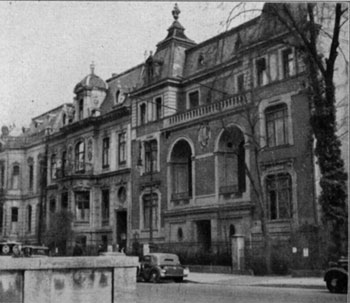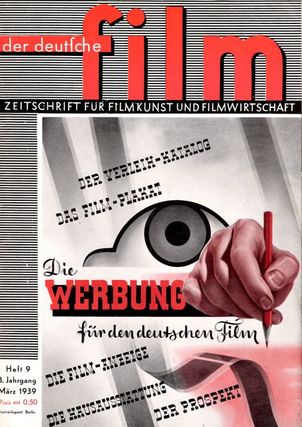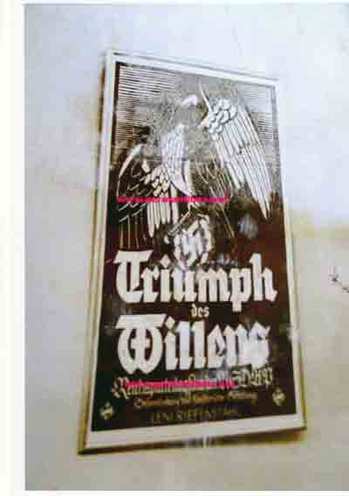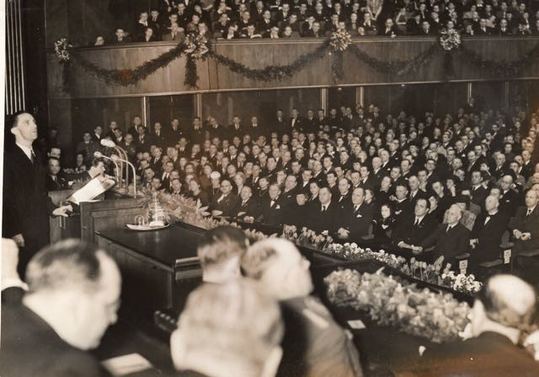- Home
- POSTER GALLERY
- ❗️BOOK & POSTER STORE❗️
- PURCHASE "HJ Quex" film ephemera HQ
- About the Posters
- The William Gillespie Collection
- Our Publishing House
- ❗️GFDN interviews author and collector William Gillespie ❗️
- Our most expensive & inexpensive finds!
- ❗️***NEW!**❗️POSTER OF THE MONTH - Blutzeugen / Raza
- ❗️NEW ❗️Film Posters – Demands on an important means of film advertising. ❗️
- In our Book + Zeitschrift Library
- ❗️ ***NEW!*** Hitler Youth Quex – A Guide for the English–speaking Reader ***NEW!*** ❗️
- ❗️***NEW!*** Table of Contents of our new HJ QUEX book❗️
- ❗️Hitler Youth Quex Guide - early praise! ❗️
- Recent loans from the Collection
- Farewell Horst Claus. (1940–2024 †)
- "Der Deutsche Film" Zeitschrift
- ❗️ ***NEW!***Reichsfilmkammer collection ❗️
- German "Tendency" Films (Tendenzfilme) in the Third Reich
- KARL RITTER
- Karl Ritter original film posers in this Collection
- "Besatzung Dora" ( † 1943)
- "The Making of The Crew of the Dora"
- Karl Ritter at the 1938 Reichsfilmkammer Congress
- INDEX -"Karl Ritter" book, 2nd edition
- Karl Ritter's Legion Condor (1939, unfinished)
- Excerpt from our "Dora" book
- ∆∆∆∆∆ High praise for our DORA book! ∆∆∆∆∆
- TABLE OF CONTENTS – "Legion Condor"
- § § § § § Early Praise for our LEGION CONDOR book! § § § § §
- ❗️"Das Leben geht weiter" and Karl Ritter ❗️
- Dateline: Ufa - April 11, 1945
- Zarah Leander Europe–wide !
- Japan Military Film and Karl Ritter
- Karl Ritter after 1945
- 1935 Film Congress
- Poster Exhibition in Berlin, March 1939
- Potsdam poster exhibition 12 April–25 August 2019
- Leni Riefenstahl's two "Olympia" Films (1938)
- "Ohm Krüger" (1941)
- Emil Jannings
- "Blutendes Deutschland" (1933)
- Hannes Stelzer ( † 1944)
- Klaus Detlef Sierck ( † 1944)
- Film stills
- Reich Film Censorship Offices
- ❗️***NEW!***The Fate of the German Film Industry in May 1945 ❗️
- Film censorship cards
- Film Archives
- Cinema advertising
- School filmstrips
- ❗️UPDATED❗️ Z F O / Ostland Film G-m-b-H
- Z F O / Herbert Jacobi estate
- ZFO / Ostland Film newspaper articles
- ❗️***NEW!*** Roter Nebel / Red Fog / Red Mist (1942/1943, ZFO) ❗️
- ZFO - Der Rückkehrer - The Returnee (1943/1944)
- The D F G production company
- D I F U
- ❗️ ***NEW!*** "Carl Peters" – Special Collection. ❗️
- "Alcazar" (1940, Genina)
- "Der 5. Juni" (1943, banned)
- Herbert Selpin and his "Titanic" (1943)
- Ein Robinson (1940, Fanck)
- "Fronttheater" (1942)
- Veit Harlan's Jud Süß and Fritz Hippler's Der Ewige Jude
- Harlan "Jud Süß" trial 1949
- Werner Krauss & JUD SÜß
- Anti-Semitic Film Posters in the Collection
- "Heimkehr" (1941)
- "Hitlerjunge Quex" (1933)
- ❗️***NEW!*** Hitlerjunge Quex in 111 Greater Berlin Cinemas ❗️
- Jürgen Ohlsen
- "S.A.Mann Brand" (1933)
- "In der roten Hölle" (Edgar Neville, 1939)
- "Helden in Spanien" (1938)
- The Spanish Civil War in Film
- Andrews Engelmann (1901 – 1992)
- Deutsche Wochenschau
- Uƒa Feldpost
- Uƒa Kulturfilm – Informationen
- " Die Tochter des Samurai" (1937, Fanck)
- Ufa 25th Anniversary
- Invitations to world premieres
- ❗️***NEW!*** Continental Films, Paris 1940–1944 ❗️
- Film Censorship in Occupied Paris 1942
- "Der Sieg des Glaubens" (1933)
- Wilhelm Althaus Estate
- Weimar Germany posters
- Ufa and the Ordensburgen
- The Gaufilmstelle in our Collection
- "Zwei Welten" (1940)
- "Capriccio" (1938) –Karl Ritter film album
- Unrealised NS Propaganda Films 1934–1945
- German Film Directors accused of "war crimes"
- Australian––themed NS feature films
- "Der Störenfried" / "The Troublemaker"
- What was new in 2014?
- What was new in 2015?
- What was new in 2016?
- What was new in 2017?
- What was new in 2018?
- What was new in 2019?
- What was new in 2020?
- What was new in 2021?
- What was new in 2022?
- What was new in 2023 ?
- What's new in 2024?
- ❗️***NEW!*** Hitler assassination attempt in Karl Ritter film cut❗️
- BESATZUNG DORA private photos
- Just discovered 1942 article on BESATZUNG DORA
- The Karl Ritter Tetralogy
- Google Analytics 2023
- Our first–ever acquisition!
- ❤️"Some of our favourite things....!"❤️
- ERRATUM for our " Hitler Youth Quex Guide"
- Trending
- Vale †
- Our Wants List / 2024 / Wunschliste
- Pop Quiz
- Unsere KARL RITTER Bücher in Deutschland liefbar!
- WHERE to buy our books right now?
- ✉️Contact
 “History is not about the facts. It is about the context and who is telling the story.” —Prof. Milton Fine.
“History is not about the facts. It is about the context and who is telling the story.” —Prof. Milton Fine.
"Who controls the past controls the future: who controls the present controls the past." –– George Orwell in his novel "1984."
"Whoever doubts the exclusive guilt of Germany for the Second World War destroys the foundation of post–war politics." –– Prof. Theodor Eschenberg, Rector, the University of Tübingen.
"If we have our own why in life, we shall get along with almost any how." – Friedrich Nietzsche
POSTER GALLERY --view
over 500 German film
original posters between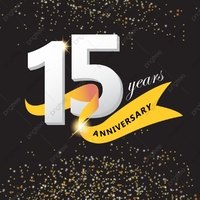
1927–1954 from
Germany and from
many Axis and Neutral countries
across Europe!
Note! Posters in the Poster Gallery are PERMANENT
acquisitions which are NOT FOR SALE!! ONLY the
posters listed in our POSTER STORE are for sale.
(They have a price and order button to use.)
Reich Film Chamber Poster Exhibition of March 1939
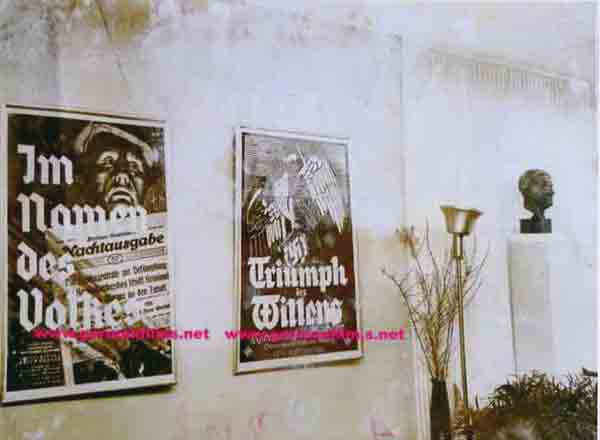
The annual meeting and ceremonies of the German Film Chamber each year in Berlin was one of official speeches, reports, exhibitions, and film screenings, which culminated in the famous Film Ball im Zoo attended by Chamber delegates, film stars and leaders of the greater film industry.
( Below: The Reichsfilmkammer office building at Bendlerstraße 33. The League of German Cimema Owners national offices were next door at 32a. Photo from Film–Kurier Tageszeitung, 25 April 1935. Special issue devoted to the International Film Congress held in Berlin. )
Despite the prominence of this annual event, it is only after decades of searching that we have been able to find a single press photo of the film poster exhibition which was opened on March 9,1939 by Chamber President, Dr. Oswald Lehnich.
Lehnich’s speech was published in the RFK’s 1939 Yearbook. In the speech he noted that each year an exhibition was installed which reflected the RFK’s realm – one on technical developments and film set model–building had been mounted the previous year, and this year attention was turned to ‘The Promotion of Film.’
This exhibition, in the Great Hall of the Kroll Opera House (shown below right, partially bombed out in 1945 and razed in 1957), displayed film publicity,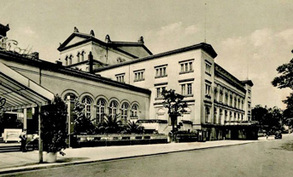 materials, posters and even the huge ‘Aussenfront’ cinema exterior hoardings/billboards heralding a film’s premiere that could be found for important films across the front of the famous Ufa Palast am Zoo cinema, for example.
materials, posters and even the huge ‘Aussenfront’ cinema exterior hoardings/billboards heralding a film’s premiere that could be found for important films across the front of the famous Ufa Palast am Zoo cinema, for example.
Lehnich pointed out in his speech that the exhibit on film promotion was using the new film by Karl Ritter, Pour le Mérite, to illustrate all aspects of film marketing – from the birth of the film through to its cinema screening.
After the exhibition opened on Thursday, 9th March, the next day was filled with speeches and reports about cinemas, domestic and foreign film sales, cultural and advertising films, Chamber membership gatherings, and at 8pm that night the keynote speech by Dr. Goebbels. The Saturday had five sequential half-hour presentations held in the Capitol am Zoo cinema; and the Film Ball at 9pm that night.
The RFK’s organ, Der Deutsche Film, put out a special March 1939 issue devoted to the same theme (cover of the magazine issue shown at left) Articles in the issue included: ‘Means of Advertising for Film,’ ‘Are Art and Advertising a Contradiction?,’ ‘Film Advertising from a Censor’s Point of View,’ ‘What we expect from a film poster,’ and others. English translations of these articles are to be found in the book Film Posters of the Third Reich by Joel Nelson and William Gillespie.
In the March 9, 1939 Film–Kurier Tageszeitung newspaper an article on the Exhibition was written by H. Schumacher. We translate it here, from our collection:
From the Flickers to the Movie Theater – the Exhibition of the Annual Conference of the Reichsfilmkammer.
This morning the exhibition of the Reichsfilmkammer, “Advertising for the German Film,” was opened at the Kroll Opera House by the President of the RFK, Prof. Dr. Oswald Lehnich. The President pointed out that this time, without the (usual) technical exhibition, we have dealt with an area that has been particularly important for many years; the exhibition of 1939 should show the way to good advertising for the German film. This advertising should be exemplary and tasteful. For this purpose the exhibition wants to provide examples.
An excellently arranged, as instructive as it is interesting, exhibition awaits visitors to the Annual Conference of the Reichsfilmkammer in the foyer of the Kroll Opera House and in the Rittersaal. The themes of From the Flickers to the Movie Theater and Advertising for the German Film, are presented here in an exemplary way. While in the foyer many large photographs of the fronts and exteriors of new German cinemas are shown – as examples of modern construction – for the contemporary view of “the face of the movie theater” – the film posters of the previous distribution year reveal the state of promotional art for film in the Rittersaal, where the exhibition of the RFK juxtaposes the past and present in example and counter-example.
Upon entering, one understands with a glance both the sense and purpose of this presentation: to put yesterday’s quite Flicker-like advertising in stark contrast to the sophisticated advertising with modern means, and to show what the movie theaters of today owe to film art.
Almost grotesque, the old-fashioned Kintopp front looks with their arcade-shaped, bulb-shaped, arranged names - with the wild and colorful and horribly bad, but oh so "real" painted house posters, – with the shabby showcases, in which poorly lit lobby cards hang, pinned with thumbtacks.
How pretty, by contrast is the opposite, much more powerful advertising façade of a modern film theater. Instead of the poorly painted entrance doors, a light-filled box office lures through glass front doors, with the name of the theater in blue fluorescent tubes, the title of the film dominates the front with backlit wooden letters and beautiful showcases show framed lobby cards.
But not only do these two fronts speak a clear language: in this exhibition one finds newspaper advertisements, posters and all film advertising from yesterday and today – photographs of horrible blatant advertising carts, images of old cinema fronts, yes even the Berlin Ufa Palace at the Zoo, it’s transformation from the noisy front posters that once ‘adorned’ it’s huge façade, to the present day; where a beautiful example of the arrangement of the cinema front shows a world premiere theater’s face artistically presented.
From the catalogue page to the distributor the promotional advertising for a film is arranged, advertising examples in public transport are suggested, and a poster pillar shows the movie advertisements of theaters of this kind.
In a special section large photographs show the direct marketing of the RFK: the German pavilion at the Biennale, the movie theater exterior for the world premiere of the Olympia film, the architectural model of the German Film Academy, as well as the brochures of the Film–Volkstagen.
The exhibition speaks for itself, we can only emphatically point out with conviction, that it’s visitors will take away with them worthy and important inspiration, and from the examples of “decadent Flickers” (as we would like to call the convincing ugly things of yesterday), recognize the need themselves to see the progress shown by the positive counter–examples from today which must help capture a place for German Film that it deserves.
In this sense a strong visitation and success for the beautiful and engrossing exhibition of the RFK is wished for – it shows the way “from the Flickers to the Film Theater” through good promotion!
(Article by H. Schumacher, Film–Kurier Tageszeitung #58, 9. März 1939, Berlin.)
Triumph des Willens film poster
Our one press photo of the poster exhibition shows the two film posters for In Namen des Volkes and for Triumph des Willens. This is the first photo of the large (“A0” format) poster graphic design of the latter film, which we have ever seen. To the right, an advertisement in an April 1935 Film-Kurier Tageszeitung announcing a box office record for Triumph des Willens, which uses the exact same graphic design as the poster shown on this RFK film poster exhibition photo page. More proof that this was indeed the official poster design.
Here is the official German Press Bureau (DNB) issued press photo of Joseph Goebbels addressing the closing session at the Kroll Opera House of the March 1939 Reich Film Chamber convention (from our photo library.)
